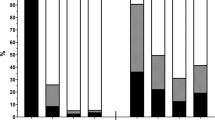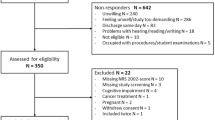Abstract
Background/objectives
Hospital malnutrition is a common problem worldwide. This study aims to assess the validity of widely used nutritional screening tools for hospitalized adults in acute care settings in Ho Chi Minh City, Vietnam.
Subjects/methods
Participants in this study were 693 adult patients from six general public hospitals, in a multi-center survey undertaken in April and May, 2016. The criterion validity of the Malnutrition Screening Tool (MST), Malnutrition Universal Screening Tool (MUST), Nutrition Risk Screening (NRS-2002) and Mini Nutrition Assessment—Short Form (MNA-SF), modified MST (MST combined with low BMI), and BMI as independent tools were assessed using Subjective Global Assessment (SGA) or low BMI (<18.5 kg/m2) as the reference method. Area under curve (AUC), sensitivity, specificity, positive predictive value (PPV), and negative predictive value (NPV) were calculated using the ROC curve method to determine the validity of screening tools.
Results
NRS-2002, modified MST (MST + low BMI), MUST, and BMI at 21 kg/m2 showed moderate/fair validity compared to the reference method (SGA or BMI). MST alone and MNA-SF showed poor validity due to low sensitivity (41.8 and 35.0% for MST and MNA-SF, respectively).
Conclusions
Based on specificity and sensitivity, the first choice for the most appropriate screening tool for use in Vietnam is the NRS-2002, following by the MST + BMI, MUST, and BMI alone at the cut-off value of 21 kg/m2. Further investigation on the feasibility and acceptability are required to determine the most appropriate screening tools for use within the Vietnamese context.
This is a preview of subscription content, access via your institution
Access options
Subscribe to this journal
Receive 12 print issues and online access
$259.00 per year
only $21.58 per issue
Buy this article
- Purchase on Springer Link
- Instant access to full article PDF
Prices may be subject to local taxes which are calculated during checkout
Similar content being viewed by others
References
Norman K, Pichard C, Lochs H, Pirlich M. Prognostic impact of disease-related malnutrition. Clin Nutr. 2008;27:5–15.
Cuong TQ, Banks M, Hannan-Jones M, Diep DTN, Gallegos D. Prevalence and associated risk factors of malnutrition among hospitalized adults in a multisite study in Ho Chi Minh City Vietnam. Asia Pacific J Clin Nutr. 2017, https://doi.org/10.6133/apjcn.042018.07.
Braunschweig C, Gomez S, Sheean PM. Impact of declines in nutritional status on outcomes in adult patients hospitalized for more than 7 days. J Am Diet Assoc. 2000;100:1316–22.
Barker LA, Gout BS, Crowe TC. Hospital malnutrition: prevalence, identification and impact on patients and the healthcare system. Int J Environ Res Public Health. 2011;8:514–27.
Mueller C, Compher C, Ellen DMASPEN. Clinical guidelines: nutrition screening, assessment, and intervention in adults. J Parenter Enter Nutr. 2011;35:16–24.
Ferguson M, Capra S, Bauer J, Banks M. Development of a valid and reliable malnutrition screening tool for adult acute hospital patients. Nutrition. 1999;15:458–64.
Elia M. The 'MUST' report. Nutritional screening for adults: a multidisciplinary responsibility. Developmentand use of the 'Malnutrition Universal Screening Tool' (MUST) for adults. BAPEN, UK, 2003.
Rubenstein LZ, Harker JO, Salvà A, Guigoz Y, Vellas B. Screening for undernutrition in geriatric practice: developing the short-form mini-nutritional assessment (MNA-SF). J Gerontol A Biol Sci Med Sci. 2001;56:M366–72.
Kondrup J, Rasmussen HH, Hamberg OLE, Stanga Z, Grp EW, Ad Hoc EWG. Nutritional risk screening (NRS 2002): a new method based on an analysis of controlled clinical trials. Clin Nutr. 2003;22:321–36.
Lim YP Malnutrition and clinical outcomes in elderly patients from a Singapore acute hospital. PhD Thesis, Queensland University of Technology, Brisbane, QLD, 2010.
Higashiguchi T, Arai H, Claytor LH, Kuzuya M, Kotani J, Lee S-D, et al. Taking action against malnutrition in Asian healthcare settings: an initiative of a Northeast Asia study group. Asia Pac J Clin Nutr. 2017;26:202–11.
Deurenberg P, Deurenberg-Yap M. Differences in body-composition assumptions across ethnic groups: practical consequences. Curr Opin Clin Nutr Metab Care. 2001;4:377–83.
Lohmann TG, Roche AF. Anthropometric standardization reference manual. Martorell Reditor. Champaign, IL: Human Kinetics; 1988.
Platek ME, Hertroijs DFL, Nicholson JM, Parekh N, Sensitivity and specificity of malnutrition screening tools used in the adult hospitalized patient setting a systematic review. Topics Clin Nutr. 2015;30:289–301.
van Bokhorst-de van der Schueren MAE, Guaitoli PR, Jansma EP, de Vet HCW. Nutrition screening tools: does one size fit all? A systematic review of screening tools for the hospital setting. Clin Nutr. 2014;33:39–58.
Anthony PS. Nutrition screening tools for hospitalized patients. Nutr Clin Pract. 2008;23:373–82.
Skipper A, Ferguson M, Thompson K, Castellanos VH, Porcari J. Nutrition screening tools: an analysis of the evidence. J Parenter Enter Nutr. 2012;36:292–8.
Beaton DE, Bombardier C, Guillemin F, Ferraz MB. Guidelines for the process of cross-cultural adaptation of self-report measures. Spine. 2000;25:3186–91.
Hanna KL, Glen KD, Lau BT, Tran CQ, Truong NT, Gallegos D. Relationship between malnutrition and selected risk factors in two hospitals in Vietnam. Nutr Diet. 2016;73:59–66.
Detsky AS, McLaughlin JR, Baker JP, Johnston N, Whittaker S, Mendelson RA, et al. What is subjective global assessment of nutritional status? J Parenter Enter Nutr. 1987;11:8–13.
White JV, Guenter P, Jensen G, Malone A, Schofield M. Consensus statement of the Academy of Nutrition and Dietetics/American Society for Parenteral and Enteral Nutrition: characteristics recommended for the identification and documentation of adult malnutrition (undernutrition). J Acad Nutr Diet. 2012;112:730–8.
Cederholm T, Bosaeus I, Barazzoni R, Bauer J, Van Gossum A, Klek S, et al. Diagnostic criteria for malnutrition - an ESPEN consensus statement. Clin Nutr. 2015;34:335–40.
StataCorp. 2007. Stata Statistical Software: Release 10. College Station, TX: StataCorp LP..
Hajian-Tilaki K. Receiver operating characteristic (ROC) curve analysis for medical diagnostic test evaluation. Casp J Intern Med. 2013;4:627–35.
Kim JY, Wie GA, Cho YA, Kim SY, Kim SM, Son KH, et al. Development and validation of a nutrition screening tool for hospitalized cancer patients. Clin Nutr. 2011;30:724–9.
Woo J, Chumlea WC, Sun SS, Kwok T, Lui HH, Hui E, et al. Development of the Chinese nutrition screen (CNS) for use in institutional settings. J Nutr Health Aging. 2005;9:203–10.
Sakinah H, Suzana S, Noor Aini MY, Philip Poi JH, Shahrul Bahyah K. Development of a local malnutrition risk screening tool-hospital (MRST-H) for hospitalised elderly patients. Malays J Nutr. 2012;18:137–47.
Lim S-L, Tong C-Y, Ang E, Lee EJ-C, Loke W-C, Chen Y, et al. Development and validation of 3-minute nutrition screening (3-MinNS) tool for acute hospital patients in Singapore. Asia Pac J Clin Nutr. 2009;18:395–403.
Acknowledgements
We would like to thank (1) Staff of Department of Nutrition and Dietetics from six participating hospitals, and staff from Nutrition Centre Ho Chi Minh City for their time and effort in helping collect data for this study; (2) statisticians Edward Gosden for his statistical advices; (3) Dr. Ekta Agarwal for her advices on the development of a protocol at an early stage. TQC was supported by an Australia Award PhD scholarship.
Author contribution
This study was done as part of PhD project of TQC and was supervised by DG, MHJ, MB, and DTND. The Project was planned and designed by TQC, DG, MB, MHJ, and DTND. Data was collected, analyzed by TQC. The original manuscript was written by TQC and then all authors participating in editing and revision. All authors have read and approved the final manuscript.
Author information
Authors and Affiliations
Corresponding author
Ethics declarations
Conflict of interest
The authors declare that they have no conflict of interest.
Rights and permissions
About this article
Cite this article
Tran, Q.C., Banks, M., Hannan-Jones, M. et al. Validity of four nutritional screening tools against subjective global assessment for inpatient adults in a low-middle income country in Asia. Eur J Clin Nutr 72, 979–985 (2018). https://doi.org/10.1038/s41430-018-0217-8
Received:
Revised:
Accepted:
Published:
Issue Date:
DOI: https://doi.org/10.1038/s41430-018-0217-8



